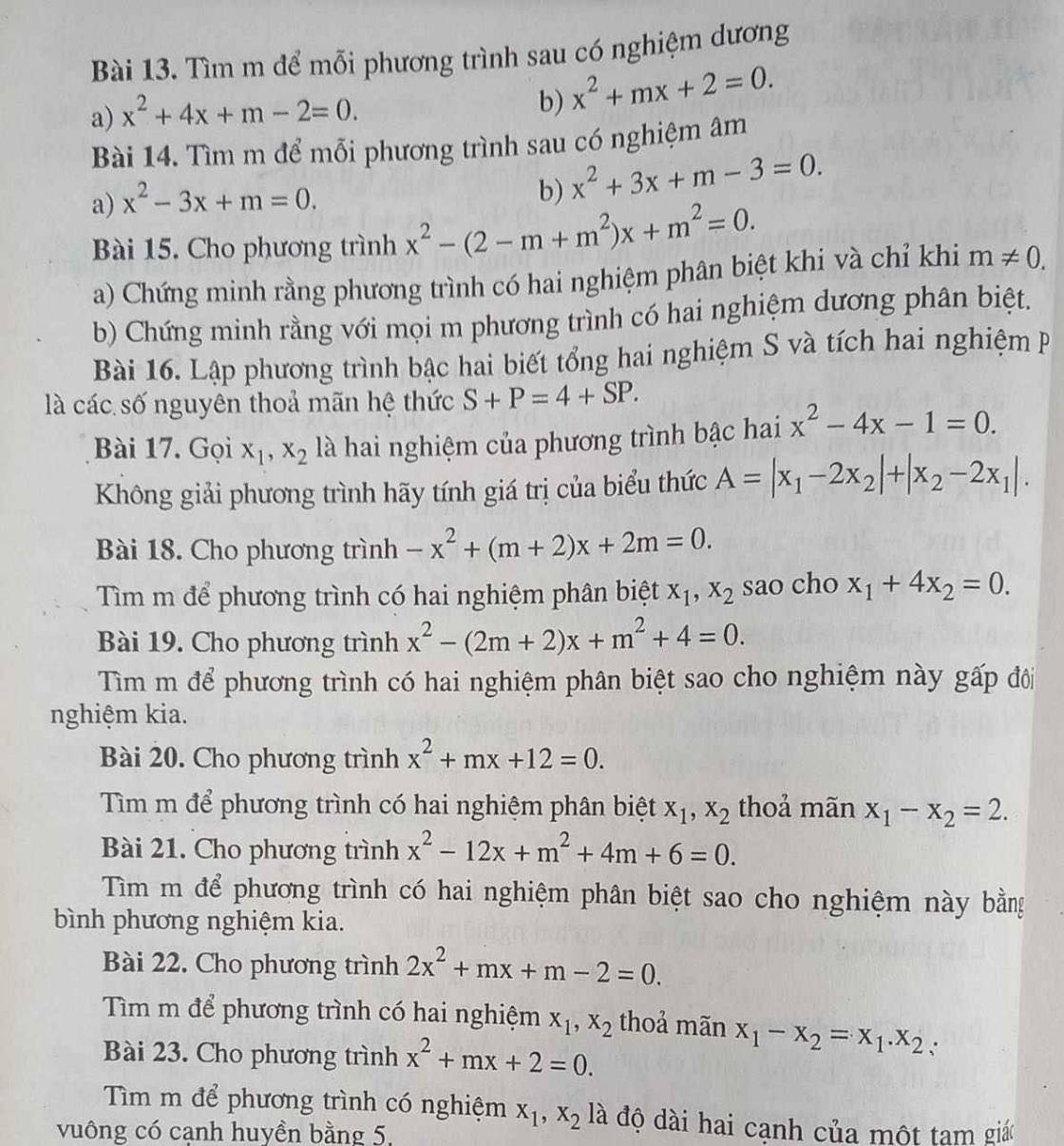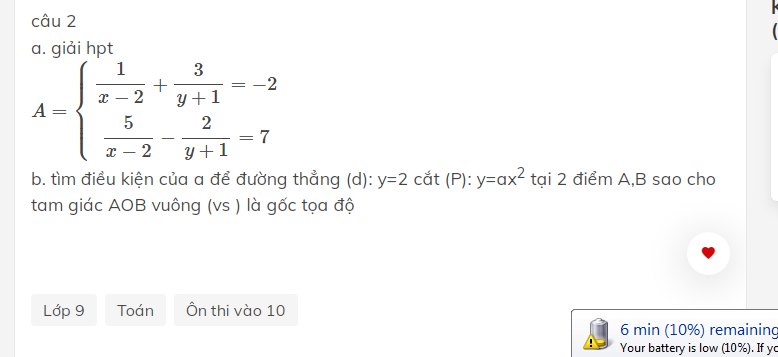
Hãy nhập câu hỏi của bạn vào đây, nếu là tài khoản VIP, bạn sẽ được ưu tiên trả lời.


15:
a: \(\text{Δ}=\left(m^2-m+2\right)^2-4m^2\)
=(m^2-m+2-2m)(m^2-m+2+2m)
=(m^2+m+2)(m^2-3m+2)
=(m-1)(m-2)(m^2+m+2)
Để phương trình co hai nghiệm phân biệt thì (m-1)(m-2)(m^2+m+2)>0
=>(m-1)(m-2)>0
=>m>2 hoặc m<1
b: x1+x2=m^2-m+2>0 với mọi m
x1*x2=m^2>0 vơi mọi m
=>Phương trình luôn có hai nghiệm dương phân biệt


b: PTHĐGĐ là;
ax^2=2
=>ax^2-2=0
Δ=0^2-4*a*(-2)=8a
Để (P) cắt (d) tại hai điểm pb thì 8a>0
=>a>0
=>x=căn 2/a hoặc x=-căn 2/a
=>vecto OA=(căn 2/a;0); vecto OB=(-căn 2/a;0); vecto AB=(2*căn 2/a;2)
Theo đề, ta có: vecto OA*vecto OB=0 hoặc vecto OA*vecto AB=0 hoặc vecto OB*vecto AB=0
=>-2*căn 2/a+2=0 hoặc 2*căn 2/a+2=0
=>căn 2/a=1
=>a=2

\(A=\dfrac{x}{x-4}+\dfrac{1}{\sqrt{x}-2}+\dfrac{1}{\sqrt{x}+2}\left(dk:x\ge0,x\ne4\right)\\ =\dfrac{x}{\left(\sqrt{x}-2\right)\left(\sqrt{x}+2\right)}+\dfrac{1}{\sqrt{x}-2}+\dfrac{1}{\sqrt{x}+2}\\ =\dfrac{x+\sqrt{x}+2+\sqrt{x}-2}{x-4}\\ =\dfrac{x+2\sqrt{x}}{x-4}\\ =\dfrac{\sqrt{x}}{\sqrt{x}-2}\)
Để \(A>1\) thì \(\dfrac{\sqrt{x}}{\sqrt{x}-2}>1\Leftrightarrow\dfrac{\sqrt{x}-\sqrt{x}+2}{\sqrt{x}-2}>0\Leftrightarrow2>0\left(LD\right)\)
\(\Leftrightarrow\sqrt{x}-2>0\Leftrightarrow x>4\left(tm\right)\)
Vậy \(x>4\) thì \(A>1\).

\(\left\{{}\begin{matrix}2y-3x=7\\y+4x=9\end{matrix}\right.\)
\(\Leftrightarrow\left\{{}\begin{matrix}8y-12x=28\\3y+12x=27\end{matrix}\right.\) \(\Leftrightarrow\left\{{}\begin{matrix}11y=55\\y+4x=9\end{matrix}\right.\) \(\Leftrightarrow\left\{{}\begin{matrix}y=5\\5+4x=9\end{matrix}\right.\)
\(\Leftrightarrow\left\{{}\begin{matrix}y=5\\x=1\end{matrix}\right.\)
Vậy nghiệm hpt: \(\left(x;y\right)=\left(1;5\right)\)

a) Thay m=3 vào hệ pt, ta được:
\(\left\{{}\begin{matrix}x+3y=3\\3x+4y=6\end{matrix}\right.\Leftrightarrow\left\{{}\begin{matrix}3x+9y=9\\3x+4y=6\end{matrix}\right.\)
\(\Leftrightarrow\left\{{}\begin{matrix}5y=3\\x+3y=3\end{matrix}\right.\Leftrightarrow\left\{{}\begin{matrix}y=\dfrac{3}{5}\\x=3-3y=3-3\cdot\dfrac{3}{5}=\dfrac{6}{5}\end{matrix}\right.\)
Vậy: Khi m=3 thì hệ phương trình có nghiệm duy nhất là \(\left(x,y\right)=\left(\dfrac{6}{5};\dfrac{3}{5}\right)\)


a) Thay m=3 vào hệ phương trình, ta được:
\(\left\{{}\begin{matrix}x+3y=3\\3x+4y=6\end{matrix}\right.\Leftrightarrow\left\{{}\begin{matrix}3x+9y=9\\3x+4y=6\end{matrix}\right.\)
\(\Leftrightarrow\left\{{}\begin{matrix}5y=3\\x+3y=3\end{matrix}\right.\Leftrightarrow\left\{{}\begin{matrix}y=\dfrac{3}{5}\\x=3-3\cdot\dfrac{3}{5}=\dfrac{15}{5}-\dfrac{9}{5}=\dfrac{6}{5}\end{matrix}\right.\)
Vậy: \(\left(x,y\right)=\left(\dfrac{6}{5};\dfrac{3}{5}\right)\)












a: \(B=\dfrac{x+\sqrt{x}-1-x+1}{\left(\sqrt{x}-1\right)\left(x+\sqrt{x}+1\right)}\cdot\dfrac{\sqrt{x}-1}{1}\)
\(=\dfrac{\sqrt{x}}{x+\sqrt{x}+1}\)
b: \(B-\dfrac{1}{3}=\dfrac{\sqrt{x}}{x+\sqrt{x}+1}-\dfrac{1}{3}\)
\(=\dfrac{3\sqrt{x}-x-\sqrt{x}-1}{3\left(x+\sqrt{x}+1\right)}\)
\(=\dfrac{-\left(\sqrt{x}+1\right)^2}{3\left(x+\sqrt{x}+1\right)}< 0\)
=>B<1/3